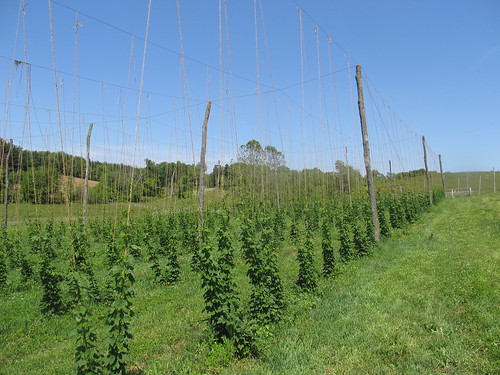For the second year in a row, U.S. hop stocks were up in March over a year earlier, an indication that hop supply has caught up with demand. That and other U.S. hops industry statistics for 2015 through 2017, as published in Capital Press (21 March 2017):
- U.S. hop growers, dealers, and brewers had 140 million pounds on hand as of 1 March 2017, as compared to 128 million at the same time in 2016, for an increase of 9 percent, according to a report by USDA National Agricultural Statistics Service. (Compare to March 2015, when hop stocks were down 2 percent from March 2014. In September 2016, pre-harvest stocks were up 2 percent from the year before and the September before they were down 8 percent.)
- A few specialty varieties still may be undersupplied, according to Ann George, executive director of Hop Growers of America and the Washington Hop Commission.
- In 2016, a record 50,857 acres of hops were harvested — mostly in Washington, Oregon, and Idaho. The production value was estimated at a record $498 million and volume was the second largest ever, at 87.1 million pounds.
- The expansion of small, 'craft' breweries has fueled the demand for more aroma hop varieties, according to Ms. George.
- The average price per pound reached $5.72 in 2016, up from $4.38 in 2015, driven by more high-value aroma varieties.
- Prices for the 2017 crop will be slightly higher than in 2016, according to Pete Mahony, director of supply chain management and purchasing for Yakima hop grower/processor John I. Haas.
- Because the 2017 crop is essentially entirely contracted under multi-year agreements pricing is still reflective of the peak of the market but will start to drop in 2018 and according to Mr. Mahoney.
- U.S. hops acreage increased 17 percent in 2016 (and production increased 11 percent). 4,000 new acres expected to be reported this year, according to Mahoney.
- A full sixty-four percent of total U.S. hop production was exported in 2016.
-----more-----
- Read the original story at the Capital Press: "U.S. hops supply catches up to demand."
- Related stories:
- YFGF is based in the southeast. Apropos of that and hops, the 2017 South Atlantic Hops Conference was held in Asheville, North Carolina 24/25 March. I hope to soon have information about the information proffered there. (Here's what transpired in 2016.)
- [U.S.] Brewers Association Releases 2016 Statistics for 'Craft' Breweries. (YFGF, 28 March 2017).
- More 'craft' barley, please! (YFGF, 23 February 2017).
- President Trump's 2016 budget proposes to cut the USDA’s statistic-creating capabilities found in the National Agricultural Statistics Service and other services. If approved, statistics such as these hop reports might be in jeopardy.
- For more from YFGF:
- Follow on Twitter: @Cizauskas.
- Like on Facebook: YoursForGoodFermentables.
- Follow on Flickr: Cizauskas.
- Follow on Instagram: @tcizauskas.












No comments:
Post a Comment
Comment here ...